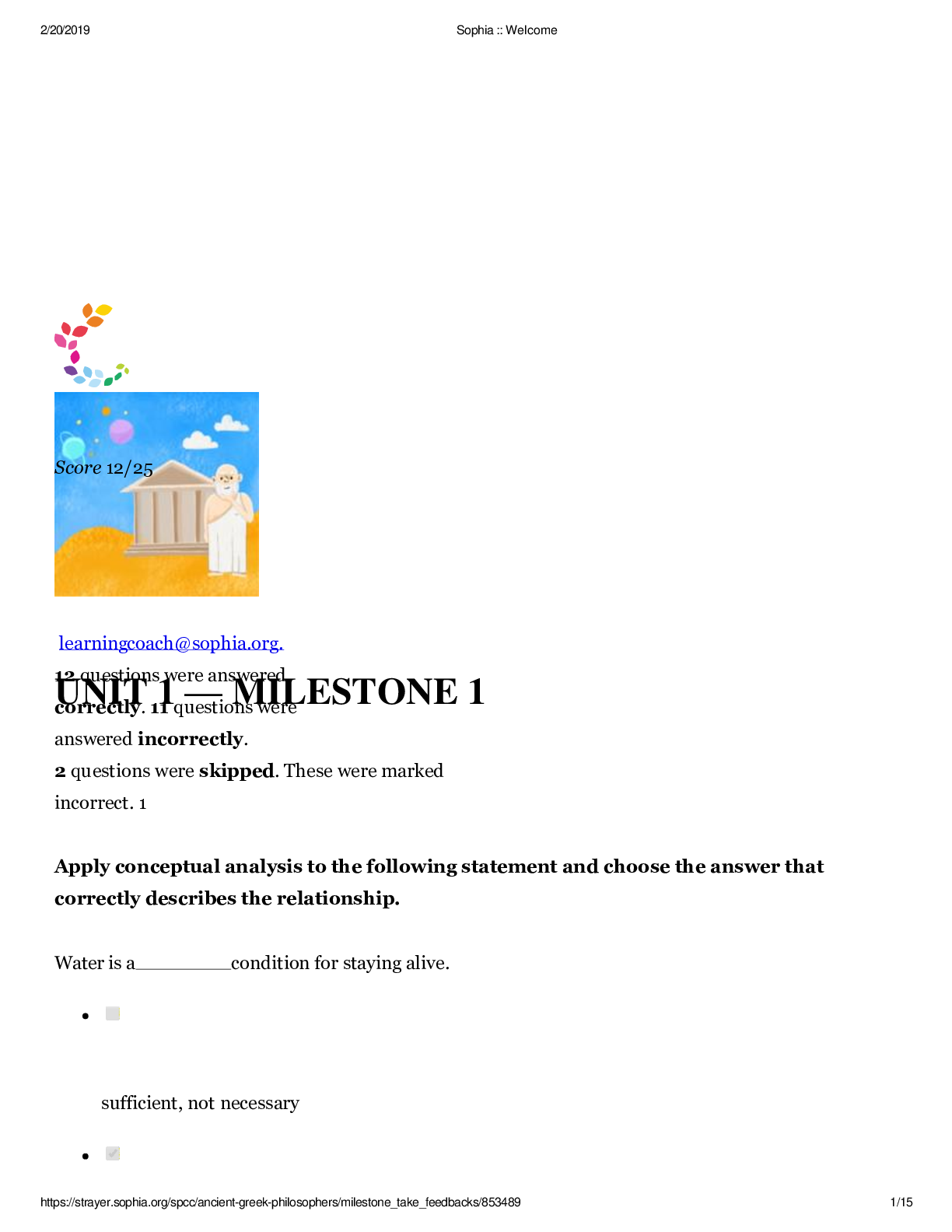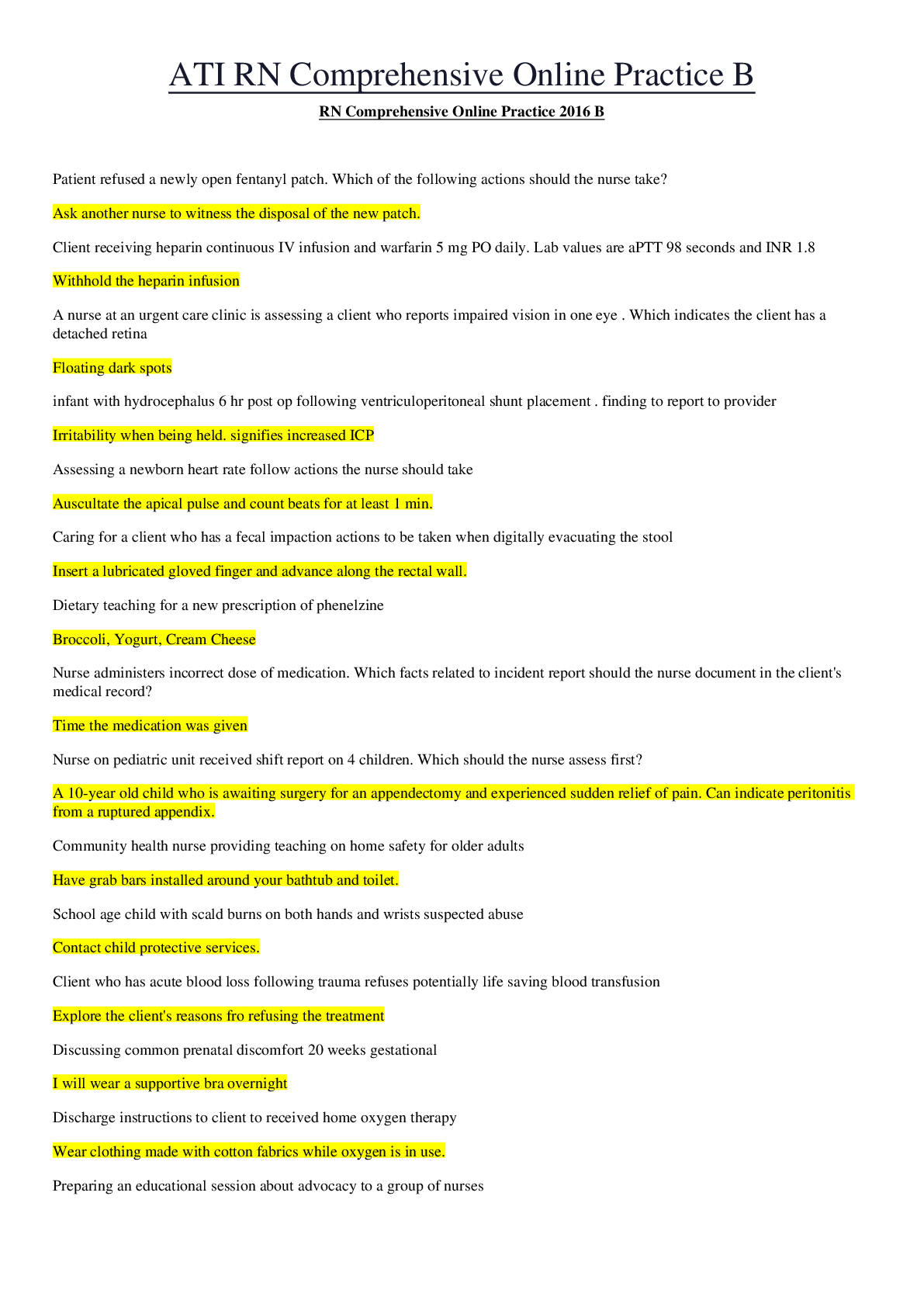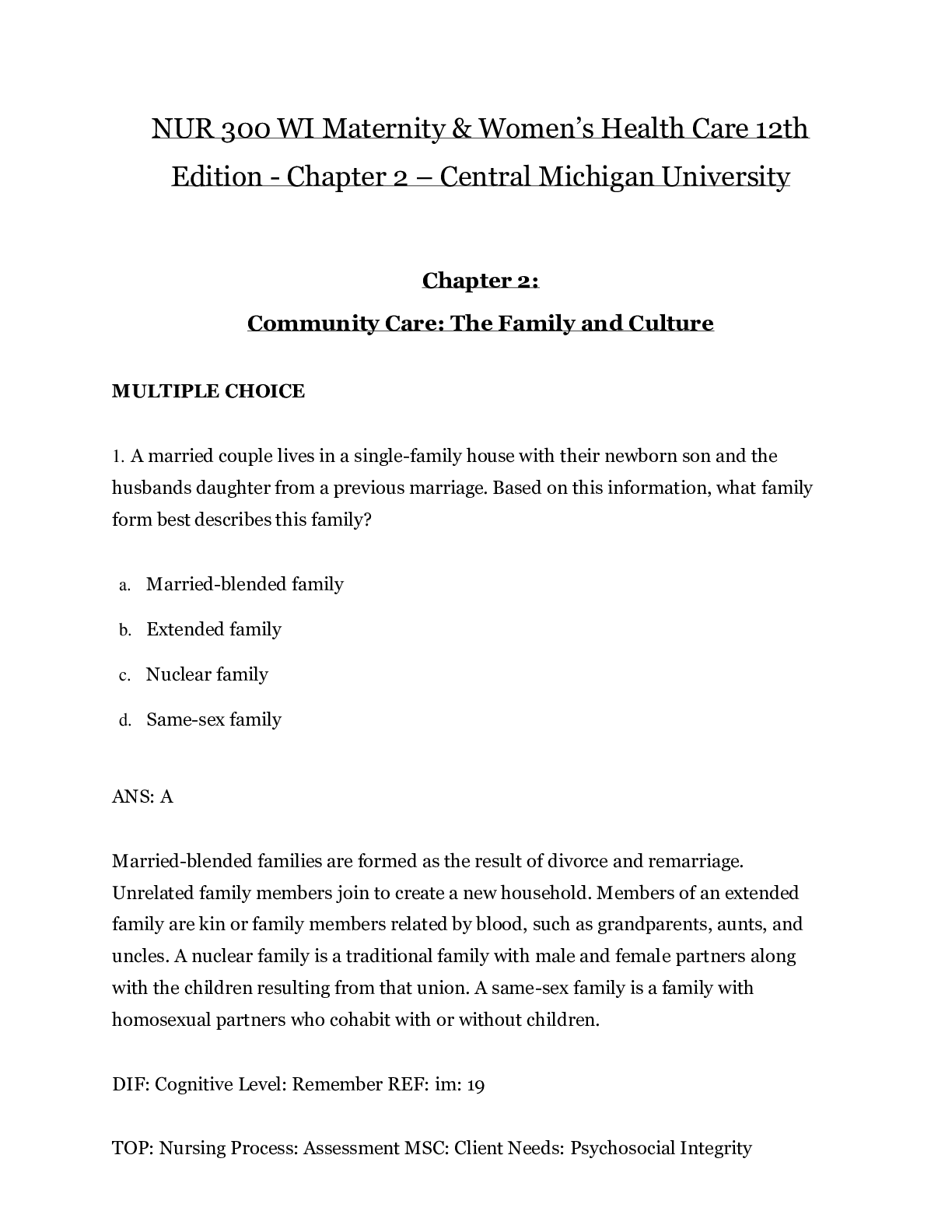*NURSING > EXAM > NUR 300 WI Maternity & Women’s Health Care 12th Edition (2019/2020) - Chapter 10 – Central Michi (All)
NUR 300 WI Maternity & Women’s Health Care 12th Edition (2019/2020) - Chapter 10 – Central Michigan University | Problems of the Breast
Document Content and Description Below
NUR 300 WI Maternity & Women’s Health Care 12th Edition - Chapter 10 – Central Michigan University Chapter 10: Problems of the Breast MULTIPLE CHOICE 1. A nurse is providing breast care e... ducation to a client after mammography. Which information regarding fibrocystic changes in the breast is important for the nurse to share? a. Fibrocystic breast disease is a disease of the milk ducts and glands in the breasts. b. It is a premalignant disorder characterized by lumps found in the breast tissue. c. Healthy women with fibrocystic breast disease find lumpiness with pain and tenderness in varying degrees in the breast tissue during menstrual cycles. d. Lumpiness is accompanied by tenderness after menses. Fibrocystic changes are palpable thickenings in the breast usually associated with pain and tenderness. The pain and tenderness fluctuate with the menstrual cycle. Fibrocystic changes are not premalignant changes; this information is inaccurate. Tenderness most often occurs before menses. DIF: Cognitive Level: Apply REF: IMS: 212 TOP: Nursing Process: Assessment MSC: Client Needs: Health Promotion and Maintenance 2. A nurse is providing education to a support group of women newly diagnosed with breast cancer. It is important for the nurse to discuss which factor related to breast cancer with the group? a. Genetic mutations account for 50% of women who will develop breast cancer. b. Breast cancer is the leading cause of cancer death in women. c. In the United States, 1 in 10 women will develop breast cancer in her lifetime. d. The exact cause of breast cancer remains unknown. The exact cause of breast cancer is unknown. Between 15% and 20% of these cancers are related to genetic mutations. Breast cancer is the second leading cause of cancer death in woman ages 45 to 55 years. One in eight women in the United States will develop breast cancer in her lifetime. DIF: Cognitive Level: Apply REF: IMS: 215 TOP: Nursing Process: Assessment MSC: Client Needs: Health Promotion and Maintenance 3. Which diagnostic test is used to confirm a suspected diagnosis of breast cancer? a. Mammogram b. Ultrasound c. Needle-localization biopsy d. Magnetic resonance imaging (MRI) When a suspicious mammogram is noted or a lump is detected, diagnosis is confirmed by either a core-needle biopsy or a needle-localization biopsy. Mammography is a clinical screening tool that may aid in the early detection of breast cancers. Transillumination, thermography, and ultrasound breast imaging are being explored as methods for detecting early breast carcinoma. An MRI is useful in women with masses that are difficult to find (occult breast cancer). DIF: Cognitive Level: Understand REF: IMS: 218 TOP: Nursing Process: Diagnosis MSC: Client Needs: Physiologic Integrity 4. A healthy 60-year-old African-American woman regularly receives health care at her neighborhood clinic. She is due for a mammogram. At her first visit, her health care provider is concerned about the 3-week wait at the neighborhood clinic and made an appointment for her to have a mammogram at a teaching hospital across town. She did not keep her appointment and returned to the clinic today to have the nurse check her blood pressure. What is the most appropriate statement for the nurse to make to this client? a. Do you have transportation to the teaching hospital so that you can get your mammogram? b. Im concerned that you missed your appointment; let me make another one for you. c. Its very dangerous to skip your mammograms; your breasts need to be checked. d. Would you like me to make an appointment for you to have your mammogram here? Offering to make an appointment for the client at the neighborhood location is nonjudgmental and gives her options as to where she may have her mammogram. Furthermore, it is an innocuous way to investigate the reasons the client missed her previous appointment. Mortality rates from breast cancer remain high for African-American women. Rather than reminding this woman that she has missed her appointment, discussing the evidence behind the recommendations for a mammogram might be preferable for the nurse. The nurse can offer to reschedule should the client agree to return for the test. Telling the client that it is dangerous to skip mammograms can be perceived as judgmental and derogatory and may alienate and embarrass the client. DIF: Cognitive Level: Apply REF: IMS: 217 TOP: Nursing Process: Planning MSC: Client Needs: Physiologic Integrity 5. A clients oncologist has just finished explaining the diagnostic workup results to her, and she still has questions. The woman states, The physician says I have a slow-growing cancer. Very few cells are dividing. How does she know this? What is the name of the test that gave the health care provider this information? a. Tumor ploidy b. S-phase index c. Nuclear grade d. Estrogen-receptor assay The S-phase index measures the number of cells in the synthesis phase of cell development. If the number of cells noted is high, then the cancer is growing at a fast rate. In this clients case, her S-phase index is assumed to be low. Tumor ploidy is the amount of deoxyribonucleic acid (DNA) in a tumor cell, compared with that in a normal cell. Nuclear grade describes the degree of abnormalities present in the cancer cell tubules, the nuclei morphologic features, and mitotic rates. Estrogen and progesterone receptors are proteins found in the cell cytoplasm and surface of some breast cancer cells. DIF: Cognitive Level: Understand REF: IMS: 219 TOP: Nursing Process: Assessment MSC: Client Needs: Physiologic Integrity 6. Breast pain occurs in many women during their perimenopausal years. Which information is a priority for the nurse to share with the client? a. Breast pain is an early indication of cancer. b. Pain is almost always an indication of a solid mass. c. Distinguishing between cyclical and noncyclical pain is important. d. Breast pain is most often treated with narcotics. Breast pain is unusual in breast cancer. Solid masses are generally benign and described as smooth, round, mobile, and painless. Distinguishing between cyclical and noncyclical pain is important to determine whether the cause is hormonal. Idiopathic pain is most often treated with nonsteroidal antiinflammatory medications. DIF: Cognitive Level: Understand REF: IMS: 212 TOP: Nursing Process: Assessment MSC: Client Needs: Health Promotion and Maintenance - - - - - - - - - - - - - - - - - - - - - - - 18. Macromastia, or breast hyperplasia, is a condition in which women have very large and pendulous breasts. Breast hyperplasia can be corrected with a reduction mammoplasty. Which statement regarding this procedure is themost accurate? a. Breast reduction surgery is covered by insurance. b. Breastfeeding might be difficult. c. No sequelae after the procedure is known. d. Pain in the back and shoulders may not be relieved. If breast reduction surgery is performed, then establishing breastfeeding at a later date may be difficult. Macromastia may not be covered by all insurance companies. A consequence of surgery may be decreased sensation and pain, secondary to scar tissue. Reduction mammoplasty will relieve chronic neck and back pain. DIF: Cognitive Level: Apply REF: IMS: 211 TOP: Nursing Process: Implementation MSC: Client Needs: Health Promotion and Maintenance 19. Having a genetic mutation may create an 85% chance of developing breast cancer in a womans lifetime. Which condition does not increase a clients risk for breast cancer? a. BRCA1 or BRCA2 gene mutation b. Li-Fraumeni syndrome c. Paget disease d. Cowden syndrome Paget disease originates in the nipple and causes nipple carcinoma and exhibits bleeding, oozing, and crusting of the nipple. BRCA1 or BRCA2, Li-Fraumeni syndrome, and Cowden syndrome are all genetic mutations that have different family pedigrees and increase the risk of breast cancer. DIF: Cognitive Level: Remember REF: IMS: 215 TOP: Nursing Process: Assessment MSC: Client Needs: Health Promotion and Maintenance 20. A client is scheduled for surgery after a recent breast cancer diagnosis. The nurse is discussing the procedure with the client. To allay her fears, which explanation best describes a skin-sparing mastectomy? a. Removal of the breast, nipple, and areola, leaving only the skin b. Removal of the breast, nipple, areola, and axillary node dissection c. Incision on the outside of the breast, leaving the nipple intact d. Removal of both breasts in their entirety A skin-sparing mastectomy is a special procedure that keeps the outer breast of the skin intact. The breast, nipple, and areola are removed. A tissue expander may be placed for later reconstruction. A modified radical mastectomy also removes the axillary lymph nodes. The nipple-sparing mastectomy is reserved for a small number of women during which the areola is removed leaving the nipple intact. Women who test positive for the BRCA1 or BRCA2 gene mutation may have both breasts removed to reduce the risk of cancer and is most commonly known as a prophylactic or preventative mastectomy. DIF: Cognitive Level: Analyze REF: IMS: 219 TOP: Nursing Process: Implementation MSC: Client Needs: Physiologic Integrity [Show More]
Last updated: 2 years ago
Preview 1 out of 22 pages

Buy this document to get the full access instantly
Instant Download Access after purchase
Buy NowInstant download
We Accept:

Reviews( 0 )
$10.50
Can't find what you want? Try our AI powered Search
Document information
Connected school, study & course
About the document
Uploaded On
Jun 28, 2020
Number of pages
22
Written in
Additional information
This document has been written for:
Uploaded
Jun 28, 2020
Downloads
0
Views
99








 – University of the People.png)

















